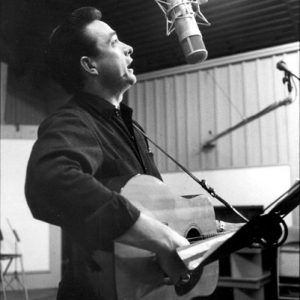calsfoundation@cals.org
Cash: The Autobiography
Published on November 1, 1997, Cash: The Autobiography was the second autobiography written by Johnny Cash. As was true of his previous memoir, Man in Black, this book contains numerous stories about his upbringing in Arkansas. Written amid Cash’s mid-1990s comeback, the book was a success among fans and critics.
Cash was Johnny Cash’s third book. After the publication of Man in Black, Cash had published a novel, Man in White, about the apostle Paul. For writing his second autobiography, he had the help of English music critic Patrick Carr. Carr conducted extensive interviews with Cash and then transcribed what Cash said in narrative form, much of it verbatim.
Cash is markedly different in tone and structure from Man in Black—a story about Cash’s religious journey in life after he overcame his drug addiction. As Cash shows, addiction was a lifelong problem for him, one made worse by other health issues and the exhaustion of constant touring. Cash also has a looser chronology than Man in Black. For example, Cash does not start with Cash’s earliest experiences, but rather begins with an overview of Cash family genealogy. He then discusses his home at “Cinnamon Hill,” a former plantation in Jamaica, including the story of a terrifying home invasion in the early 1980s, when he and his family were held hostage for hours, although ultimately left unhurt.
Cash shows that Arkansas was central to Cash’s understanding of himself and his world. Early on, Cash discusses growing up in Dyess (Mississippi County) and life in the cotton fields during the Great Depression. Cash does not romanticize farm work. “It exhausted you,” he notes, “it hurt your back a lot, and it cut your hands. That’s what I hated most.” Despite the occasional struggles with invasive army worms, Cash noted that harvesting was a happy time and the fields at times looked beautiful. He also recalled his taste for tiny, sweet pink bolls in the cotton that he liked to eat.
Man in Black was published in 1975, when Cash was enjoying a career peak. But by the late 1970s, Cash was struggling to find good material and make hit records. In the 1980s, he had heart surgery, and added to his health problems was an addiction to pain killers. He was dropped from his record label, Columbia, after nearly thirty years and had also gone through many low periods with his wife, June Carter, and other close family members. By 1994, however, he had another career comeback courtesy of his collaboration with producer Rick Rubin on his all-acoustic album American Recordings. Following American Recordings, Cash enjoyed commercial and critical success—not as much as in the late 1960s, but certainly more than at any point since the early 1970s. Cash reveals a man who is grateful for what he has but is also world weary. Success and fame had not been easy on Cash.
Cash is much darker in tone than Man in Black. In it, Cash recounts his suicide attempt in Nickajack Cave in Tennessee around 1967, an experience he had not discussed in his first autobiography. Some historians—not to mention Cash’s bassist Marshall Grant—have doubted the accuracy of Cash’s cave story, but it illustrates how low Cash was at that point.
Another noticeable difference between Cash and Man in Black is Cash’s attitude toward his father, Ray. In Man in Black, Cash heaped praise on Ray, who was still alive, for his hard work and persistence during the Great Depression. But by 1997, his father was dead, and Cash seems more frank about his childhood and family relationships, especially about his father’s alcoholism and abusiveness. (Ray was a self-described “evil man.”)
Not only does the book reveal how much of a monster Ray Cash could be (and even worse stories were cut from the final draft), Cash relates again the story of his brother Jack dying in a sawmill accident in Dyess in 1944. In the book, Cash also laments the obvious decline of his hometown. Upon returning to Dyess in the 1990s, Cash was startled by how flat and treeless the landscape had become. His boyhood home had become a wreck, and the town’s population was a fraction of what it was during the Great Depression. “The house itself was very far gone,” he writes of the family’s Dyess farmhouse, “falling slowly into the Delta mud.” Cash notes, “I didn’t remember the land being that flat.” His home would eventually be restored by Arkansas State University, but not until after his death.
Cash was issued in hardcover and as a mass market paperback. The book sold well and was positively reviewed. Kirkus called it a “pungent, substantive” book, while Publisher’s Weekly remarked that it was a “gentle, moving memoir” in which readers could sense “Cash’s formidable presence in every terse phrase.” In the 2000 movie High Fidelity, the main character, a music fanatic and record store owner named Rob (played by John Cusack), said Cash was his favorite book.
For additional information:
Cash, Johnny, and Patrick Carr. Cash: The Autobiography. New York: Harper Collins, 1997.
“Cash: An Autobiography.” Publisher’s Weekly. https://www.publishersweekly.com/9780062515001 (accessed March 31, 2023).
“Cash: The Autobiography.” Kirkus Reviews, October 1, 1997. https://www.kirkusreviews.com/book-reviews/johnny-cash/cash/ (accessed March 31, 2023).
Cash, Johnny. Man in Black. Grand Rapids, MI: Zondervan, 1975.
Grant, Marshall. I Was There When It Happened: My Life with Johnny Cash. Nashville: Cumberland House, 2006.
Hilburn, Robert. Johnny Cash: The Life. New York: Little, Brown, 2013.
“Patrick Carr,” American Rambler, October 12, 2017. https://americanrambler.libsyn.com/episode-65-patrick-carr (accessed March 31, 2023).
Woodward, Colin Edward. Country Boy: The Roots of Johnny Cash. Fayetteville: University of Arkansas Press, 2022.
Colin Edward Woodward
Richmond, Virginia
 Divergent Prosperity and the Arc of Reform, 1968–2022
Divergent Prosperity and the Arc of Reform, 1968–2022 Literature and Authors
Literature and Authors Johnny Cash
Johnny Cash 



Comments
No comments on this entry yet.